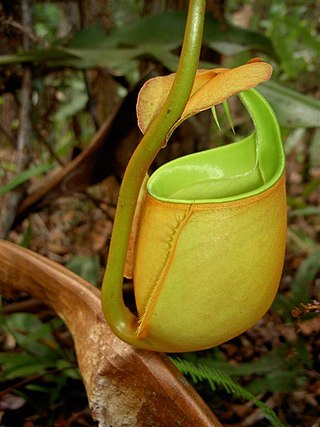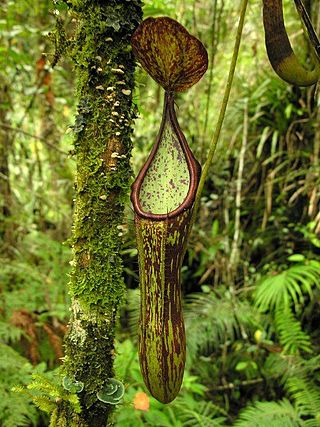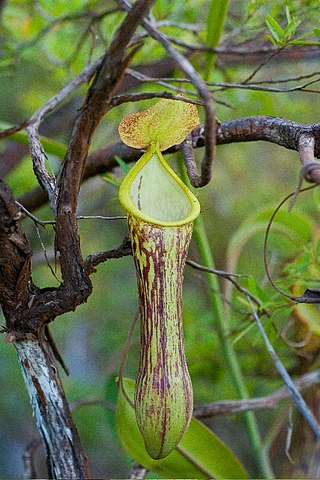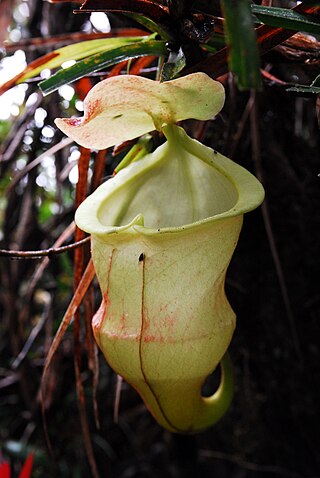
Nepenthes is a genus of carnivorous plants, also known as tropical pitcher plants, or monkey cups, in the monotypic family Nepenthaceae. The genus includes about 170 species, and numerous natural and many cultivated hybrids. They are mostly liana-forming plants of the Old World tropics, ranging from South China, Indonesia, Malaysia, and the Philippines; westward to Madagascar and the Seychelles (one); southward to Australia (four) and New Caledonia (one); and northward to India (one) and Sri Lanka (one). The greatest diversity occurs on Borneo, Sumatra, and the Philippines, with many endemic species. Many are plants of hot, humid, lowland areas, but the majority are tropical montane plants, receiving warm days but cool to cold, humid nights year round. A few are considered tropical alpine, with cool days and nights near freezing. The name "monkey cups" refers to the fact that monkeys were once thought to drink rainwater from the pitchers.

Nepenthes rafflesiana, or Raffles' pitcher-plant, is a species of tropical pitcher plant. It has a very wide distribution covering Borneo, Sumatra, Peninsular Malaysia, and Singapore. Nepenthes rafflesiana is extremely variable, with numerous forms and varieties described. In Borneo alone, there are at least three distinct varieties. The giant form of this species produces enormous pitchers rivalling those of N. rajah in size.

Nepenthes sibuyanensis is a tropical pitcher plant endemic to Sibuyan Island in the Philippines, after which it is named.

Nepenthes bicalcarata, also known as the fanged pitcher-plant, is a tropical pitcher plant endemic to northwestern Borneo, Indonesia. It is a myrmecophyte noted for its mutualistic association with a species of ant, Camponotus schmitzi. As an ant-fed plant it lacks many of the features that characterise the carnivorous syndrome in Nepenthes, including viscoelastic and highly acidic pitcher fluid, the waxy zone of the pitcher interior, and possibly even functional digestive enzymes.

Nepenthes veitchii, or Veitch's pitcher-plant, is a Nepenthes species from the island of Borneo. The plant is widespread in north-western Borneo and can also be found in parts of Kalimantan. It grows in lowland Dipterocarp forest, typically near rivers, and on ridgetops in mossy forests, from 0 to 1,600 meters elevation. Nepenthes veitchii usually grows as an epiphyte, though the form from Bario seems to be strictly terrestrial and has not been observed to climb trees.

Nepenthes mirabilis, or the common swamp pitcher-plant and tropical pitcher plant, is a carnivorous plant species. By far the most widespread of all Nepenthes, its range covers continental Southeast Asia and all major islands of the Malay Archipelago, stretching from China in the north to Australia in the south. The species exhibits great variability throughout its range. One of the more notable varieties, N. mirabilis var. echinostoma, is endemic to Brunei and Sarawak and possesses an extremely wide peristome.

Nepenthes ventricosa is a tropical pitcher plant endemic to the Philippines, where it is a highland species, growing at an elevation of 1,000–2,000 metres (3,300–6,600 ft) above sea level. It has been recorded from the islands of Luzon, Panay, and Sibuyan. The pitchers are numerous, growing up to 20 centimetres (8 in) tall and ranging in colour from ivory white to red.

Nepenthes macrophylla, the large-leaved pitcher-plant, is a tropical pitcher plant known only from a very restrictive elevation on Mount Trusmadi in Sabah, Malaysian Borneo.

Nepenthes alata is a tropical pitcher plant endemic to the Philippines. Like all pitcher plants, it is carnivorous and uses its nectar to attract insects that drown in the pitcher and are digested by the plant. It is highly polymorphic, and its taxonomy continues to be subject to revisions.

Nepenthes copelandii is a species of pitcher plant native to the island of Mindanao in the Philippines. Originally known from Mount Apo near Davao City and Mount Pasian near Bislig, it has since been discovered on a number of peaks throughout Mindanao. It may also be present on the nearby island of Camiguin. The species has a wide altitudinal distribution of 1100–2400 m above sea level. Nepenthes copelandii has no known natural hybrids. No forms or varieties have been described.

Nepenthes mindanaoensis is a tropical pitcher plant native to the Philippine islands of Mindanao and Dinagat.

Nepenthes philippinensis is a tropical pitcher plant endemic to the Philippines. It is known from Palawan and the neighbouring Calamian Islands and Linapacan, where it grows at 0–600 metres (2,000 ft) above sea level.

Nepenthes eustachya is a tropical pitcher plant endemic to Sumatra, where it grows from sea level to an elevation of 1600 m. The specific epithet eustachya, formed from the Greek words eu (true) and stachys (spike), refers to the racemose structure of the inflorescence.

Nepenthes tobaica is a tropical pitcher plant endemic to Sumatra. It is particularly abundant around Lake Toba, after which it is named.

Nepenthes petiolata is a highland Nepenthes pitcher plant species endemic to Mindanao island in the Philippines, where it grows at an elevation of 1,450–1,900 metres (4,800–6,200 ft) above sea level.
Nepenthes × truncalata is a natural hybrid involving N. alata and N. truncata. Like its two parent species, it is endemic to the Philippines, but limited in distribution by the natural range of N. truncata on Mindanao.
Nepenthes × merrilliata is a natural hybrid involving N. alata and N. merrilliana. Like its two parent species, it is endemic to the Philippines, but limited by the natural range of N. merrilliana to Samar as well as Mindanao and its offshore islands.

Nepenthes hamiguitanensis is a tropical pitcher plant endemic to a single peak on the Philippine island of Mindanao, where it grows at elevations of 1200–1600 m above sea level. Once thought to be a natural hybrid between N. micramphora and N. peltata, this plant is now considered a species of possible hybridogenic origin. It produces squat upper pitchers that vary greatly in pigmentation, from red speckled to yellow throughout.
Nepenthes 'LeeAnn Marie' is a cultivar of a manmade hybrid involving N. alata and N. ventricosa. It was bred by Bruce Lee Bednar in 1982. This cultivar name is not established as it was published without a description, violating Article 24.1 of the International Code of Nomenclature for Cultivated Plants. It is a later synonym of N. × ventrata and first appeared in print in the March 1994 issue of the Carnivorous Plant Newsletter as "x “LeeAnn Marie”". Bednar and Bramblett listed its parentage as "ventricosa x ventrata G".
















